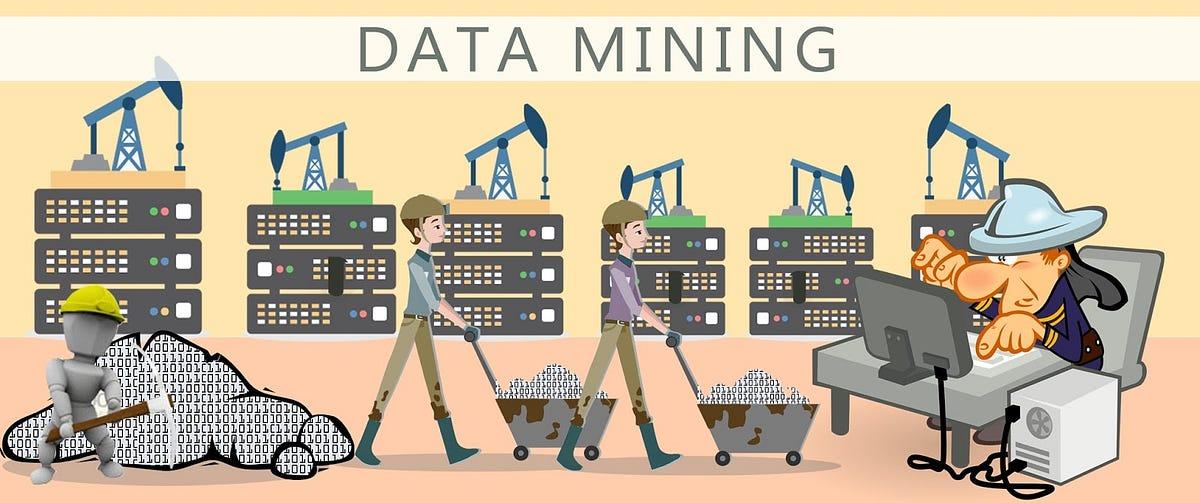
A Comprehensive Guide to Data Mining: Uncovering the Tricks to Locating Undiscovered Treasures.
The vast amount of information that surrounds us is subjugated by data. Every day, a vast amount of data is produced by both individuals and businesses, and crucial insights are waiting to be discovered somewhere in this sea of data. This is the point at which data mining is useful. With the use of data mining, we can effectively sort through noise and identify significant patterns, trends, and information from huge databases. We will explore the definition, methods, applications, and effects of data mining on various industries as we embark on a journey to decipher its complexity in this essay.
Methods and Approaches for Data Mining:
A wide range of techniques and methods are used in the data mining process to look for patterns and information inside datasets. These methods can be divided into many main groups, which are as follows:
1. Looking for Association Rules through Mining
This methodology’s main goal is to find interesting connections between variables in large datasets. In a retail setting, for example, it might reveal that customers who purchase product A are more likely to purchase product B as well. This could suggest that buyers of both products are more inclined to make larger purchases overall.
2. The following is the classification:
Classification is the process of assigning predefined labels to data according to that data’s characteristics. This approach is widely utilized in several domains, such as spam filtering, where emails are classified as spam or not based on several characteristics.
3. Grouping Grouping:
Clustering is the process of assembling similar groupings of data items according to their inherent characteristics. It facilitates the finding of naturally occurring divisions in the data, opening the door to the identification of patterns that might not be immediately apparent.
4. Analysis of Regression:
Regression analysis is the process of determining how one or more independent variables and a dependent variable are related. It is particularly useful for estimating numerical results and understanding the degree of correlation between variables.
5. Recognizing Abnormal Situations:
The main goal of anomaly detection is to identify unusual patterns or outliers in a dataset. This is critical in fields like fraud detection, where unusual transaction patterns can indicate illegal activity.
Numerous Uses for Data Mining:
Numerous industries and commercial sectors can benefit from the extensive uses of data mining, which has the potential to revolutionize organizational operations. Here are a few noteworthy instances of applications:
1. Marketing and Business:
In the business sector, data mining is used to analyze customer behavior, identify present and potential market trends, and enhance marketing strategies. It gives companies the ability to tailor their products and services to the preferences of specific clients, which increases client happiness and loyalty.
2. Medical Care
Numerous applications of data mining are found in the medical industry, such as medication optimization, patient monitoring, and illness prediction. Medical experts can identify tendencies that may point to the onset of a certain illness by analyzing patient data. Better patient outcomes result from early intervention, which is made possible by this.
3. The financial system
Financial institutions employ data mining for investment opportunity analysis, fraud detection, and risk management. By closely reviewing massive databases, they are able to spot possible threats, identify fraudulent activities, and make well-informed investment decisions.
4. The educational domain:
The identification of traits that support student achievement, performance prediction, and the personalization of learning opportunities are just a few of the educational applications of data mining. This enables educators to modify their pedagogical approaches to suit the unique needs of every learner.
The Effects of Data Mining:
Data mining has far-reaching consequences that cut across many different business domains and change the way we approach problem-solving and decision-making. By utilizing the power of data, organizations may gain a competitive edge, make decisions based on reliable information, and uncover opportunities that might have remained undiscovered.
Now that we have established the fundamental concepts of data mining and are prepared to move on to more sophisticated material, let’s take a closer look at some specific methods that enable this process.
1. [Decision Trees] “Decision Trees:”
Graphical models known as decision trees are used to represent decisions and the outcomes that may follow. In the context of data mining, they are employed for regression analysis and categorization. Decision-making procedures can be visually represented thanks to the tree structure, which greatly facilitates understanding of the relationships between the variables.
2. Networks of Neurals:
Inspired by the structure and functions of the human brain, neural networks consist of interconnected nodes that process data in layers. Two fields that stand to gain a great deal from the use of this technique are pattern recognition and predictive modeling. Neural networks are highly adaptive and have the capacity to learn; image and speech recognition are only two of the numerous applications that substantially benefit from these qualities.
3. “Support Vector Machines, generally known as “SVM,”
Support vector machines, or SVMs, are supervised learning techniques used for regression and classification tasks. They work by identifying the hyperplane in the feature space that best separates the different classes into distinct groups. Text classification and image recognition are two examples of applications that heavily rely on SVMs because they work particularly well in high-dimensional domains.
4. The KNN algorithm, also called K-Nearest Neighbors:
The data points are categorized based on the class that is held by the majority of their k-nearest neighbors using the KNN method, which is popular for a number of applications, including recommendation systems. It is easy to understand and use, making it a powerful method for both classification and regression work.
5. Textual analysis
Text mining, sometimes referred to as text analytics, is a methodology that concentrates on extracting valuable information and insights from unstructured text data. Natural language processing (NLP) techniques are widely applied in text data analysis because they simplify sentiment analysis, topic modeling, and information retrieval.
Real-World Case Studies Illustrating the Conversion of Data into Useful Insights
While a thorough understanding of data mining techniques is essential, real-world examples of instances when data mining has had a significant impact are the most effective approach to illustrate the true potential of this technology.
1. What is the “Netflix Recommendation System:”
The company’s strong reliance on data mining has greatly enhanced Netflix’s recommendation algorithm, allowing it to provide users with personalized content based on their viewing habits, interests, and viewing histories. This keeps users engaged and satisfied with the service, which not only improves the user experience but also helps to keep existing customers.
2. The method by which Google calculates PageRank:
The introduction of Google’s PageRank algorithm, one of the first applications of data mining, completely changed the landscape of web search. PageRank is a system that analyzes the link structure of the web to determine the relevance and importance of individual web pages, allowing Google to return more relevant and accurate search results for users.
3. Using predictive analytics in the medical field
Healthcare professionals use predictive analytics, a subset of data mining, to estimate patient outcomes, optimize treatment plans, and improve overall patient care. By using predictive models to identify high-risk patients, physicians can take proactive steps to avoid negative outcomes.
4. Identification of Fraud in Electronic Commerce:
E-commerce platforms employ data mining technologies to detect fraudulent activity. By examining transaction patterns, user behavior, and other pertinent variables, these systems can detect and stop fraudulent conduct, safeguarding the business and its clients.
Thoughts on an Ethical Basis: Navigating the Data Minefield
In the context of data mining, important considerations include issues pertaining to data privacy, algorithmic bias, and the appropriate use of data. Finding a happy medium between technological advancement and adherence to moral standards is necessary in order to achieve this delicate balancing act. It is important to note that data mining presents a number of difficult ethical questions despite its enormous potential for great change.
As we continue our investigation into the ethical aspects of data mining, we will address these issues and look at the frameworks and procedures that are now in place to avert potential risks in the section that follows.
Navigating the Moral Orientation
As the field of data mining continues to grow, it is imperative that we bring attention to the ethical issues that are becoming more and more pressing. To fulfill our mission of expanding knowledge and producing insightful analysis, we must guarantee the protection of individual privacy, address biases, and responsibly utilize the data that is mined.
1. Privacy-Related Concerns
The vast amount of data that is gathered and processed throughout the mining process poses significant challenges to users’ right to privacy. Improper handling of personal data can result in privacy breaches. The data mining industry requires a careful ethical balancing act between the extraction of actionable insights from data and the protection of individual privacy.
2. The Presence of Algorithm Bias:
A prerequisite for engaging in ethical data mining is the detection and correction of inherent biases in data mining algorithms. The biases that are already present in society are often reflected in the data that is mined for insights. When algorithms are trained with pre-biased data, those biases can be reinforced and even made worse by the algorithms themselves. These biases have far-reaching consequences, influencing decision-making processes in fields like hiring, lending, and criminal justice, among others.
3. “Consent After Being Informed”
From a moral perspective, obtaining the informed consent of the people whose data is being mined is imperative. Transparency in the data collection process and honest communication about the intended use of the data are also necessary to foster trust between data miners and the people whose information is being collected. Respecting the autonomy of individuals can guarantee ethical behavior in the sector.
4. A Few Safety-Related Barriers:
The more data that is mined and stored, the more security concerns arise. Ethical data mining necessitates the adoption of strict security protocols to protect confidential data from illegal access. This helps guarantee that personal information is not vulnerable to hacks or breaches.
5. “Ownership of Data and Accountability” :
Setting up frameworks for responsible data stewardship can help guarantee that the benefits of data mining are realized without compromising the integrity of the data’s source. It is morally imperative to establish clear lines of responsibility between who is responsible for using the data and who owns it. People should own their own data, and businesses should be held accountable for using it ethically.
Analyzing the Past to Predict the Future: Data Mining in a Time of Accelerated Development
Since the ethical minefield is just one of many ethical minefields, it is imperative that we look to the future and consider how technological and societal advancements may affect the data mining landscape as we navigate it. The following trends are likely to have an impact on the trajectory of data mining in the coming years:
1. The exponential growth in data volume
Global data production is expected to grow exponentially in the coming years, and as technology advances, so too will the development of data mining techniques to handle larger and more complex datasets, opening up new avenues for innovation and discovery.
2. Recent developments in artificial intelligence (AI):
AI, and machine learning in particular, will have a big impact on data mining in the future. AI algorithms’ ability to learn new things and adapt their behavior will make data mining processes more precise and effective, which will lead to more insightful and accurate forecasts/analysis.
3. Cooperation Among Different Fields
With data scientists, domain experts, ethicists, and policymakers collaborating, the field of data mining is quickly becoming interdisciplinary. This collaborative approach guarantees that a well-rounded perspective is achieved, taking into account not only the ethical considerations and societal ramifications, but also the technical obstacles.
4. An Emphasis on the Liabilities Associated with AI:
The need for responsible AI procedures is only going to increase. Organizations and researchers will prioritize developing and implementing ethical frameworks, rules, and standards to oversee the use of data mining and artificial intelligence. Responsible AI prioritizes justice, transparency, and accountability when making algorithmic decisions.
Final thoughts:
As our investigation into data mining draws to a close, we have learned about its complexities, explored its practical applications, and examined the ethical issues raised by this powerful technology. However, in order to successfully navigate the data minefield, we must approach data mining with ethical precision, which means recognising its potential to transform industries while also ensuring the appropriate use of information.

Geeta Technical Hub
Related Posts
IOT Security
IOT Security 1 The Internet of Things (IoT) has ushered in a new era of connectivity, transforming the way we interact with the world

Understanding Common Adulterants: From Chemical Additives to Contaminants”
Understanding Common Adulterants: From Chemical Additives to Contaminants” Food adulteration is a pervasive issue that has plagued the food industry for centuries. It involves the

Why Choose MCA Program – Geeta University
Why Choose MCA Program – Geeta University After earning a Bachelor of Computer Application or any bachelor’s degree relating to computers, students can pursue a


